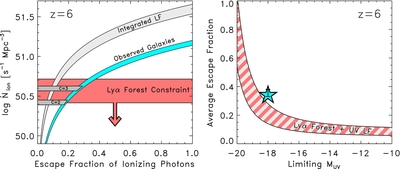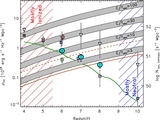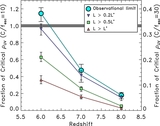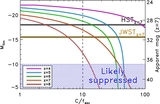Image Details

Caption: Figure 5.
Left: the inferred emission rate of ionizing photons from our (incompleteness-corrected) observed sample of z = 6 galaxies (cyan; the width of curve denotes the 68% confidence range), as well as from the z = 6 luminosity function of Bouwens et al. (2008) integrated down to M UV = −10 (left side of light-gray curve) and −15 (right side). Both quantities are plotted as a function of the escape fraction of ionizing photons. The red region denotes the constraints on this quantity at z = 6 from the Lyα forest, with the lower and upper edges representing the 1σ and 2σ constraints from Bolton & Haehnelt (2007), respectively. The dark gray bands denote the emission rate of ionizing photons necessary to sustain reionization for a given value of the clumping factor. Right: the striped curve shows the allowed average escape fraction of ionizing photons from galaxies as a function of the limiting UV absolute magnitude, assuming the z = 6 luminosity function of Bouwens et al. (2007), based on the 2σ constraints from the Lyα forest. The cyan star shows the allowed escape fraction from our observations with its associated uncertainty. If the galaxy luminosity function turns over shortly faintward of our observations, then the average escape fraction of ionizing photons is constrained to be f esc < 34% (17%) at 2σ (1σ). If the luminosity function extends down to M UV = −13, then this constraint tightens to f esc < 13% (6%) at 2σ (1σ). These escape fractions can still reionize the IGM if the clumping factor is ~2–3.
Copyright and Terms & Conditions
© 2012. The American Astronomical Society. All rights reserved.









